Contacts:
Diana Hannikainen, Observing Editor, Sky & Telescope
+1 617-500-6793 ×22100, [email protected]
Gary Seronik, Consulting Editor, Sky & Telescope
[email protected]
Kerry Hensley, Deputy Press Officer, American Astronomical Society
+1 202-328-2010 ×138, [email protected]
Note to Editors/Producers: This release is accompanied by high-quality graphics; see the end of this release for the images and links to download.
On the night of December 7–8, Mars will be at opposition — opposite the Sun’s position in the sky. On that date, Earth is situated directly between Mars and the Sun. The planet is at its brightest, rising as the Sun sets and setting as the Sun rises. Opposition and closest approach to Earth, however, are offset by several days due to the relative shape and orientation of each planet’s orbit. Mars and Earth were closest on the night of November 30–December 1 when they were separated by 81.5 million kilometers (50.6 million miles).
But that’s not all. On opposition night, viewers across large swaths of the globe will see the full Moon glide in front of Mars, in what is known as an occultation. Much of North America, northern Mexico, most of Europe, and northern Africa will be privy to this spectacle, provided skies are clear, of course. For North America, the occultation takes place in the convenient evening hours of December 7th. “If you’re outside this occultation zone, don’t despair,” says Diana Hannikainen, Observing Editor at Sky & Telescope. “The sight of the Red Planet skimming below the lunar disk will be an unforgettable experience nevertheless.”
Mars oppositions occur at roughly 26-month intervals, when Earth catches up to the Red Planet as they circle the Sun. The most recent opposition was in October 2020 and the next one will be in January 2025. The next time North America will be treated to the sight of Mars disappearing behind the Moon will be on the evening of January 13, 2025, two days before opposition.
How and When to Watch Mars Disappear Behind the Moon
The Moon will be easy to find on the evening of December 7th. Just step outside, face east, and you’ll see it gleaming in Taurus. Depending on your location, Mars will be left or lower left of the bright lunar disk. That evening, the Red Planet will shine at magnitude –1.8, even brighter than Sirius, the brightest star in the night sky.
As the occultation begins, the Moon will be traveling leftward in the sky toward Mars. Because Mars presents a disk, albeit a small one, it will take the Moon many seconds, even as much as a minute, to gobble up the planet, depending on your viewing location. This is different than when the Moon eclipses distant, pinpoint stars, which disappear in an instant. The length of time that the Moon hides the Red Planet is again location-dependent — for some viewers Mars will only be missing from the sky for a matter of minutes, others won’t see the planet for more than an hour.
At the conclusion of the event, Mars re-emerges on the righthand side of the lunar disk, as the Moon moves away from the Red Planet. Even if you miss the beginning of the event, it’s still worth trying to catch the reappearance of Mars.
Binoculars will come in handy to follow Mars as it slips behind the lunar disk on one side and reappears on the other — or, if you’re outside the occultation zone, to see it brush past the lower edge of the Moon. A telescope will be even better; if you don’t have access to one yourself, you can check if a nearby astronomy club is hosting a viewing party. Look for one near you in Sky & Telescope's club listings.
Here’s a selection of disappearance and reappearance times for select North American cities:
| City | Disappearance | Reappearance |
| Los Angeles, CA | 6:30 p.m. PST | 7:30 p.m. PST |
| Seattle, WA | 6:52 p.m. PST | 7:51 p.m. PST |
| Vancouver, BC | 6:55 p.m. PST | 7:52 p.m. PST |
| Phoenix, AZ | 7:32 p.m. MST | 8:31 p.m. MST |
| Denver, CO | 7:45 p.m. MST | 8:48 p.m. MST |
| St. Louis, MO | 9:06 p.m. CST | 9:52 p.m. CST |
| Chicago, IL | 9:11 p.m. CST | 10:05 p.m. CST |
| Toronto, ON | 10:29 p.m. EST | 11:18 p.m. EST |
Here are times for when Mars is closest to the Moon outside the occultation zone:
| New Orleans, LA | 9:11 p.m. CST |
| Huntsville, AL | 9:23 p.m. CST |
| Miami, FL | 10:16 p.m. EST |
| Atlanta, GA | 10:26 p.m. EST |
| Washington, DC | 10:46 p.m. EST |
| New York, NY | 10:56 p.m. EST |
| Boston, MA | 11:01 p.m. EST |
For a more comprehensive list of locations, head over to the International Occultation Timing Association’s page dedicated to the event.
Sky & Telescope is making the illustrations below available to editors and producers. Permission is granted for nonexclusive use in print and broadcast media, as long as appropriate credits (as noted) are included. Web publication must include a link to skyandtelescope.org.
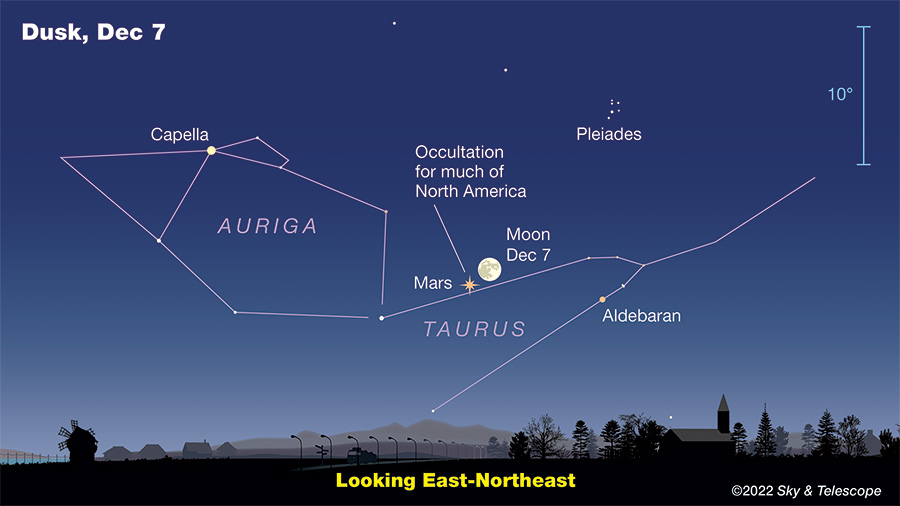
This sky scene is for about an hour after sunset on the evening of December 7, 2022, when viewers can start admiring the sight of the full Moon and Mars close together. As the evening hours proceed, the Moon approaches Mars and will eclipse the planet for certain geographic locations. Others will see the Red Planet skim below the lower edge of the Moon. A high-resolution version of this sky scene is available.
Sky & Telescope
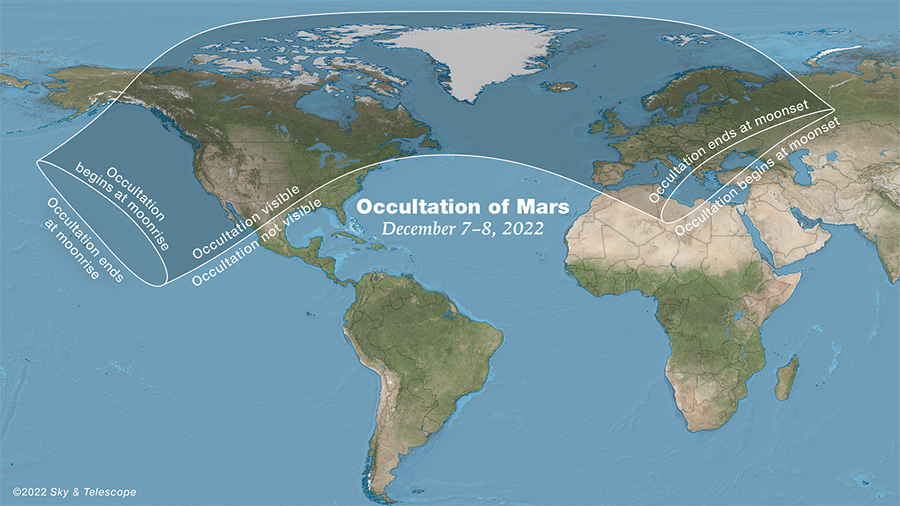
The Moon will cover Mars for viewers across much of North America, northern Mexico, and most of Europe, as well as northern Africa. In North America, the sight will unfold in the evening hours of December 7th, whereas it will be a predawn spectacle for those in Europe and northern Africa on December 8th. A high-resolution version of this map is available.
Gregg Dinderman / Sky & Telescope
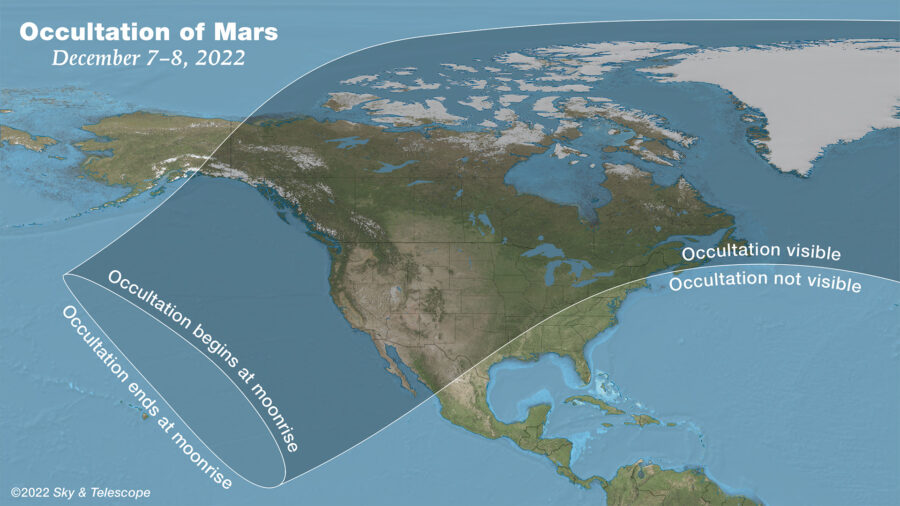
Viewers in North America in the shaded areas on the map will enjoy the the sight of the Moon eclipsing Mars — provided skies are clear — on the evening of December 7th. A high-resolution version of this map is available.
Gregg Dinderman / Sky & Telescope
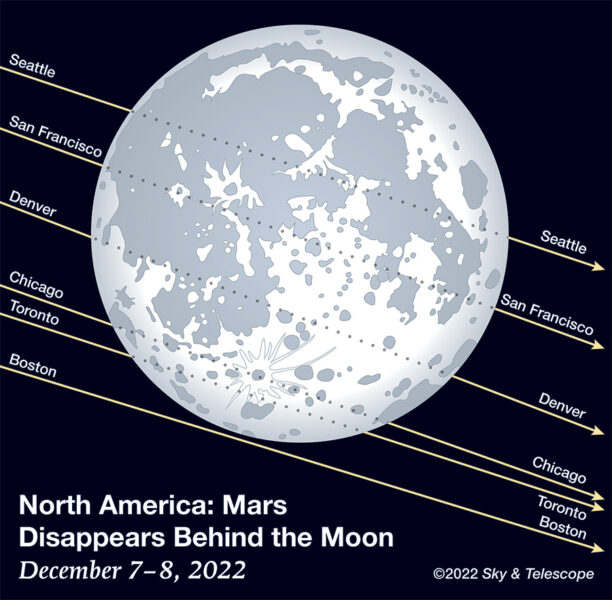
Depending on where viewers are in North America, they'll either see the Moon fully cover Mars or watch as it skims below the lower edge of the lunar disk.
Gregg Dinderman / Sky & Telescope
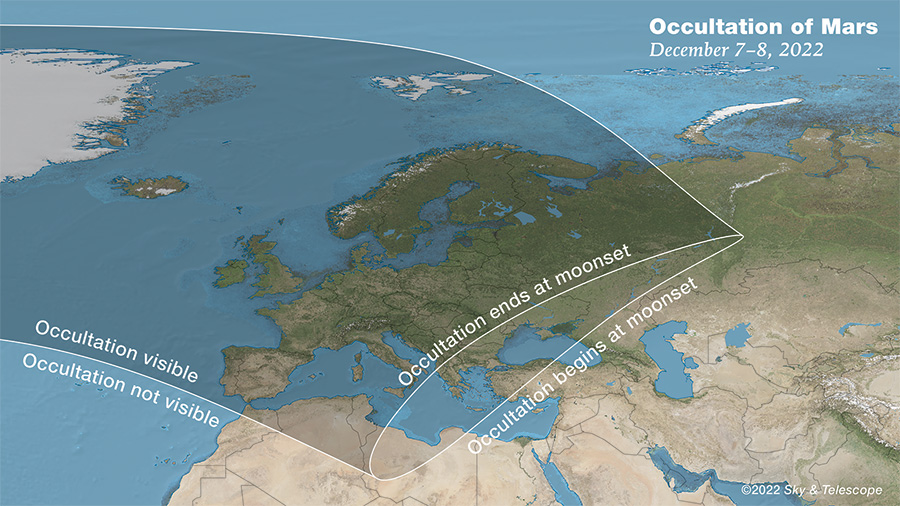
Viewers in Europe and northern Africa in the shaded areas on the map will enjoy the the sight of the Moon eclipsing Mars — provided skies are clear — in the wee hours of December 8th. A high-resolution version of this map is available.
Gregg Dinderman / Sky & Telescope
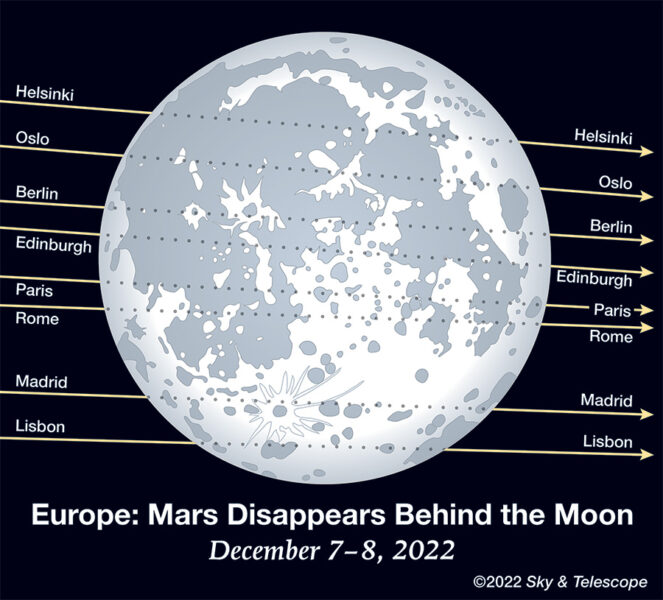
Viewers in most of Europe will see the full Moon eclipse the Red Planet.
Gregg Dinderman / Sky & Telescope
For skywatching information and astronomy news, visit skyandtelescope.org or pick up Sky & Telescope magazine, the essential guide to astronomy since 1941. Sky & Telescope and skyandtelescope.org are published by the American Astronomical Society, along with SkyWatch (an annual beginner's guide to the night sky) as well as books, star atlases, posters, prints, globes, apps, and other products for astronomy enthusiasts.
The American Astronomical Society (AAS), established in 1899, is a major international organization of professional astronomers, astronomy educators, and amateur astronomers. Its membership of approximately 8,000 also includes physicists, geologists, engineers, and others whose interests lie within the broad spectrum of subjects now comprising the astronomical sciences. The mission of the AAS is to enhance and share humanity’s scientific understanding of the universe as a diverse and inclusive astronomical community, which it achieves through publishing, meetings, science advocacy, education and outreach, and training and professional development.
 0
0









Comments
You must be logged in to post a comment.